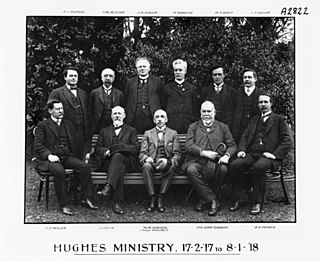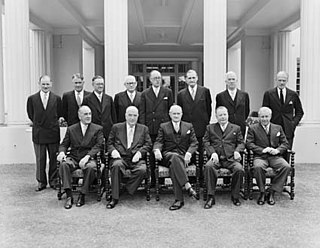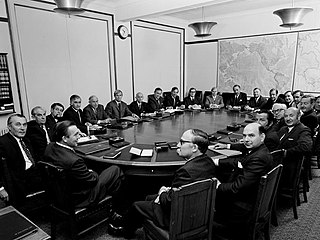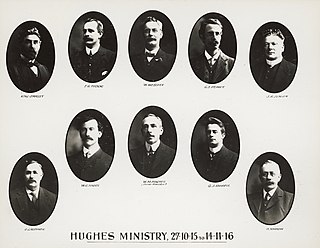
The Third Fisher Ministry (Labor) was the 10th ministry of the Government of Australia. It was led by the country's 5th Prime Minister, Andrew Fisher. The Third Fisher Ministry succeeded the Cook Ministry, which dissolved on 17 September 1914 following the federal election that took place on 5 September which saw Labor defeat Joseph Cook's Commonwealth Liberals. The ministry was replaced by the First Hughes Ministry on 27 October 1915 following Fisher's retirement from Parliament to become the next High Commissioner to the United Kingdom.

The Second Hughes Ministry was the 12th ministry of the Government of Australia. It was led by the country's 7th Prime Minister, Billy Hughes. The Second Hughes Ministry succeeded the First Hughes Ministry, which dissolved on 14 November 1916 following the split that took place within the governing Labor Party over the issue of conscription. This led to Hughes and his supporters leaving the party to form the National Labor Party, which swiftly received parliamentary support from Joseph Cook and the Commonwealth Liberal Party. The ministry was replaced by the Third Hughes Ministry on 17 February 1917 after National Labor and Commonwealth Liberal merged into the Nationalist Party.

The Third Hughes Ministry (Nationalist) was the 13th ministry of the Government of Australia. It was led by the country's 7th Prime Minister, Billy Hughes. The Third Hughes Ministry succeeded the Second Hughes Ministry, which dissolved on 17 February 1917 after the governing National Labor Party merged with the Commonwealth Liberal Party to form the Nationalist Party. The National Labor Party itself formed as a consequence of the split that took place within the then-governing Labor Party over the issue of conscription. The ministry was replaced by the Fourth Hughes Ministry on 8 January 1918 following the resignation of Hughes as Prime Minister after a vote of no-confidence within the Nationalist Party in the wake of a failed second referendum on conscription. However, due to a lack of alternative leaders, Hughes was immediately re-commissioned as Prime Minister by Governor-General Sir Ronald Munro Ferguson.

The Fourth Hughes Ministry (Nationalist) was the 14th ministry of the Government of Australia. It was led by the country's 7th Prime Minister, Billy Hughes. The Fourth Hughes Ministry succeeded the Third Hughes Ministry, which dissolved on 8 January 1918 following the resignation of Hughes as Prime Minister after a vote of no-confidence within the Nationalist Party in the wake of a failed second referendum on conscription. However, due to a lack of alternative leaders, Hughes was immediately re-commissioned as Prime Minister by Governor-General Sir Ronald Munro Ferguson. The ministry was replaced by the Fifth Hughes Ministry on 3 February 1920 following the 1919 federal election.

The First Bruce Ministry was the 16th ministry of the Government of Australia. It was led by the country's 8th Prime Minister, Stanley Bruce. The First Bruce Ministry succeeded the Fifth Hughes Ministry, which dissolved on 9 February 1923 following the December 1922 federal election and the subsequent resignation of Billy Hughes as Prime Minister. The Nationalists had lost their majority in the election, and had no choice but to negotiate a Coalition deal with the Country Party. However, Country leader Earle Page let it be known that no deal could be made unless Hughes resigned. It is the first ministry that consists of a centre-right Coalition between the senior conservative party and the junior rural party - this Coalition has more or less endured to this day with the modern-day Liberal Party and National Party. The ministry was replaced by the Second Bruce Ministry on 18 December 1925 following the 1925 federal election.
The Second Bruce Ministry was the 17th ministry of the Government of Australia. It was led by the country's 8th Prime Minister, Stanley Bruce. The Second Bruce Ministry succeeded the First Bruce Ministry, which dissolved on 18 December 1925 following the federal election that took place in November. The ministry was replaced by the Third Bruce Ministry on 29 November 1928 following the 1928 federal election.

The Third Bruce Ministry was the 18th ministry of the Government of Australia. It was led by the country's 8th Prime Minister, Stanley Bruce. The Third Bruce Ministry succeeded the Second Bruce Ministry, which dissolved on 29 November 1928 following the federal election that took place in November. The ministry was replaced by the Scullin Ministry on 22 October 1929 following the federal election that took place on 12 October which saw Labor defeat the Coalition. That election also saw Bruce lose his own seat of Flinders; no sitting Prime Minister would lose his own seat again until 2007.
The Third Lyons Ministry was the 22nd ministry of the Government of Australia. It was led by the country's 10th Prime Minister, Joseph Lyons. The Third Lyons Ministry succeeded the Second Lyons Ministry, which dissolved on 9 November 1934 after Lyons entered into a formal Coalition with Earle Page and his Country Party; the second such coalition after that of the Bruce Government. The ministry was replaced by the Fourth Lyons Ministry on 29 November 1937 following the 1937 federal election.

The Second Menzies Ministry was the 26th ministry of the Government of Australia. It was led by the country's 12th Prime Minister, Robert Menzies. The Second Menzies Ministry succeeded the First Menzies Ministry, which dissolved on 14 March 1940 after Menzies entered into a formal Coalition with Archie Cameron and his Country Party. The ministry was replaced by the Third Menzies Ministry on 28 October 1940 following the 1940 federal election.
The Third Menzies Ministry was the 27th ministry of the Government of Australia. It was led by the country's 12th Prime Minister, Robert Menzies. The Third Menzies Ministry succeeded the Second Menzies Ministry, which dissolved on 28 October 1940 following the federal election that took place in September. However, as a result of that election the government was reduced to minority status, and were forced to rely on the votes of independent crossbenchers Alexander Wilson and Arthur Coles to survive. The ministry was replaced by the Fadden Ministry on 28 August 1941 following the resignation of Menzies.

The Fourth Menzies Ministry was the 34th ministry of the Government of Australia. It was led by the country's 12th Prime Minister, Robert Menzies. The Fourth Menzies Ministry succeeded the Second Chifley Ministry, which dissolved on 19 December 1949 following the federal election that took place on 10 December which saw the Coalition defeat Ben Chifley's Labor Party. The ministry was replaced by the Fifth Menzies Ministry on 11 May 1951 following the 1951 federal election.

The Fifth Menzies Ministry was the 35th ministry of the Government of Australia. It was led by the country's 12th Prime Minister, Robert Menzies. The Fifth Menzies Ministry succeeded the Fourth Menzies Ministry, which dissolved on 11 May 1951 following the federal election that took place in April. The ministry was replaced by the Sixth Menzies Ministry on 9 July 1954 following the 1954 federal election.

The Sixth Menzies Ministry was the 36th ministry of the Government of Australia. It was led by the country's 12th Prime Minister, Robert Menzies. The Sixth Menzies Ministry succeeded the Fifth Menzies Ministry, which dissolved on 9 July 1954 following the federal election that took place in May. The ministry was replaced by the Seventh Menzies Ministry on 11 January 1956 following the 1955 federal election.

The Seventh Menzies Ministry was the 37th ministry of the Government of Australia. It was led by the country's 12th Prime Minister, Robert Menzies. The Seventh Menzies Ministry succeeded the Sixth Menzies Ministry, which dissolved on 11 January 1956 following the federal election that took place in the previous December. It is the first ministry to consist of a two-tier ministry, with only senior ministers being members of Cabinet, while the other ministers are in the outer ministry. With the exception of the Whitlam Government and the caretaker First Fraser Ministry, this practice has endured to this day. The ministry was replaced by the Eighth Menzies Ministry on 10 December 1958 following the 1958 federal election.

The Eighth Menzies Ministry was the 38th ministry of the Government of Australia. It was led by Prime Minister Robert Menzies. The Eighth Menzies Ministry succeeded the Seventh Menzies Ministry, which dissolved on 10 December 1958 following the federal election that took place in late November. The ministry was replaced by the Ninth Menzies Ministry on 22 December 1961 following the 1961 federal election.

The Ninth Menzies Ministry was the 39th ministry of the Government of Australia. It was led by the country's 12th Prime Minister, (Sir) Robert Menzies. The Ninth Menzies Ministry succeeded the Eighth Menzies Ministry, which dissolved on 22 December 1961 following the federal election that took place in early December. The ministry was replaced by the Tenth Menzies Ministry on 18 December 1963 following the 1963 federal election.

The Tenth Menzies Ministry was the 40th ministry of the Government of Australia. It was led by the country's 12th Prime Minister, Sir Robert Menzies. The Tenth Menzies Ministry succeeded the Ninth Menzies Ministry, which dissolved on 18 December 1963 following the federal election that took place in November. The ministry was replaced by the First Holt Ministry on 26 January 1966 following the retirement of Menzies.

The Second Gorton Ministry was the 45th ministry of the Government of Australia. It was led by the country's 19th Prime Minister, John Gorton. The Second Gorton Ministry succeeded the First Gorton Ministry, which dissolved on 12 November 1969 following the federal election that took place in October. The ministry was replaced by the McMahon Ministry on 10 March 1971 following the resignation of Gorton.

The McMahon Ministry was the 46th ministry of the Government of Australia. It was led by the country's 20th Prime Minister, William McMahon. The McMahon Ministry succeeded the Second Gorton Ministry, which dissolved on 10 March 1971 following the resignation of John Gorton as Prime Minister. The ministry was replaced by the First Whitlam Ministry on 5 December 1972 following the federal election that took place on 2 December which saw Labor defeat the Coalition.

The First Hughes Ministry (Labor) was the 12th ministry of the Government of Australia. It was led by the country's 7th Prime Minister, Billy Hughes. The First Hughes Ministry succeeded the Third Fisher Ministry, which dissolved on 27 October 1915 following Andrew Fisher's retirement from Parliament to become the next High Commissioner to the United Kingdom. The ministry was replaced by the Second Hughes Ministry on 14 November 1916 following the split that took place within Labor over the issue of conscription. This led to Hughes and his supporters leaving the party to form the National Labor Party.




































